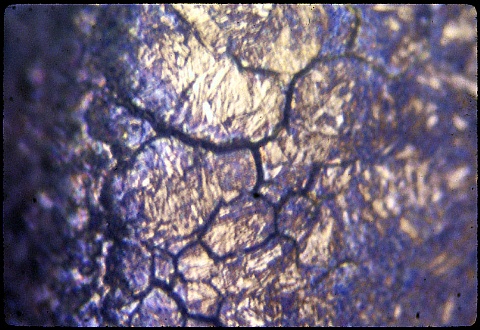
The gear had susbstandard hardness.
Both photomicrographs were taken at 500X with a Nital etch.

The grain boundary network extends unusually deeply.
Continue to the Summary for this lesson.
 |
This nitrided gear was botched because the ammonia
dissociated excessively some time after nitriding was started.
Too much of the atomic nitrogen was turned into molecular nitrogen (N2). The gear had susbstandard hardness. Both photomicrographs were taken at 500X with a Nital etch. |
 |
The nitrides decomposed near the surface, while cracks
appeared at the surface of the gear ... because of shrinkage due to the
reversal of the previous volume increase during the initial nitriding. The grain boundary network extends unusually deeply. Continue to the Summary for this lesson.
|
| SUMMARY for the entire set, Low Alloy Steels: The versatility of steel, which enables us to vary its properties over a wide range, also permits us to make more mistakes than with non polymorphic metals. Thus, you have seen many failures in heat treatment and in service which are the result of incomplete phase changes, undesirable phase transformations, unwanted phases and microconstituents, or detrimental phase morphologies. Even the compositions of phases and microconstituents can go awry, decarburization can occur, or there could be micro- or macro- segregation. This is all in addition to environmental problems such as corrosion, oxidation, and unplanned temperature excursions. |
| These problems
can develop from
inadequate quality control (e.g. the
seams in that chair spring), uncontrolled environment (caustic embrittlement in a boiler),
misapplication (high carbon steel
brazed to brass bellows), lack of attention to detail (the austempered pliers), abuse (careless abrasive cutoff), "more
is
better" reasoning (the too-soft
leather knife, austenitized too hot) and so on. |
| The moral to be learned from this set of specimens is: |
| Before
processing a steel, be sure you understand not only what you are doing, but also what it will be doing ! |